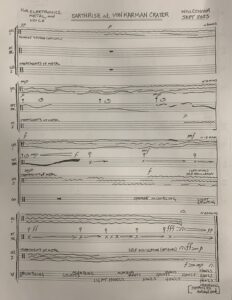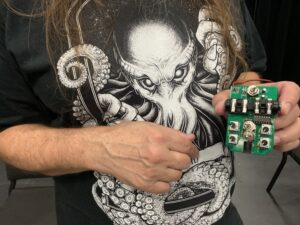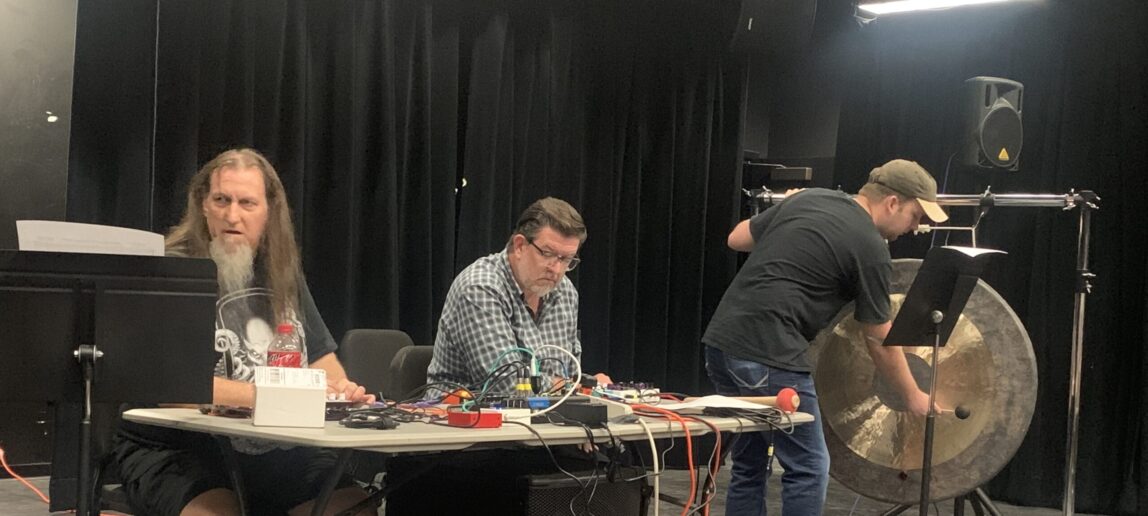New Performance Series Begins With Original Music Collaboration
The Texas A&M College of Performance, Visualization and Fine Arts debuted its new Performance Series on Sept. 6 at the Black Box Theater in the Liberal Arts and Arts and Humanities building.
The series, hosted by the Performance Studies program, continues Wednesday at 4 p.m. with a performance by Dr. Virginia Figueiredo, instructional associate professor in music-woodwinds and a clarinetist. As a soloist and chamber musician, she has toured throughout the United States, Europe, South America and Asia.
Texas A&M students, faculty and staff can experience or perform live music, theater, dance and more through the series, which continues Oct. 11 and 18; Nov. 1, 15 and 29. Anyone interested can register on the series sign-up form.
During the event’s debut, Dr. Will Connor, lecturer, performed an original piece of music titled “Earthrise at Von Karman Crater” alongside Jeffrey Morris, professor, and Robert Rutherford, senior Performance Studies major.

The 20-minute score was performed by graphic notation, which Connor described as the representation of music through visual symbols rather than standard music notation. These symbols are drawn out on a music sheet, some taking the form of squiggly lines that vary in length, thickness and shape.
“Graphic notation is literally a picture,” Connor said. “For this particular score, the notation, instead of a specific note that is played, is a generalized suggested pitch or suggested dynamic. The thicker the line is, the more energetic or warbly a sound might be, and there are different types of interpretation. But it is still a picture.”
Connor played a nandamonium that he made based on a “NAND” circuit that employs three oscillators. It consists of multiple switch controls and dials on a palm-size panel. Rutherford played a tam-tam, a type of gong without a resonating center bump, that was connected to three guitar pedals with multiple knobs, including a polyphonic modulator, delay, chorus and noise generator. Morris controlled the pitch and modulation of the sounds coming from the tam-tam through the chain of effects pedals.
Connor’s inspiration for the score came from H.P. Lovecraft, an American author known as the “father of cosmic horror” who died in 1937. Among Lovecraft’s creations were creatures on the moon. After watching a newscast about a recent discovery on the moon, Connor said he wanted the piece to tell a story of ghouls witnessing Earthrise.
“That is kind of what this piece is going to be about, ghouls in particular,” Connor said before the performance. “That ‘After you die, you become a ghoul on the moon’ — that is the Lovecraftian version of afterlife. We are going to explore Earthrise from the moon, at the place where scientists discovered this new substance: a conglomerate of other minerals that had just been melted together, and it’s right outside the Von Karman Crater on the south side of the moon.’”
With Lovecraft’s horror stories and the recent discovery in mind, Connor started to ponder what a ghoul would sound like. He began by saying English words out loud, but would butcher them to intermingle with mumbling, grunting and howling sounds he made. Once he found a rhythm in the words and animal-like sounds, he settled on these for the performance of the new piece.

“It was a dynamic build-up from a low energy to a high energy,” Connor said. “Then a specific incorporation of the mumblings and the howlings on purpose to counter the sheer electronic elements that had kind of taken over. But I also wanted those to be equally as ambient and chaotic and noisy at the same time.”
Once Connor’s vocals were established, he looked to incorporate the tam-tam to add an acoustic style to the electronic piece. He asked Rutherford to play the tam-tam for the performance only a week prior.
Connor said he wrote out the score on paper the night before the debut. As Rutherford looked over the markings on the music sheet just an hour before the performance, he could see a mix of different letters, wavy lines, circles, words and other symbols.
It was Rutherford’s first time to play the tam-tam.
“I was a little bit nervous, but then I realized I am reading something in graphic notation, which leaves a lot open to the performer,” Rutherford recalled. “I feel like I know Dr. Connor well enough to know what he was intending with the piece, and what he wanted out of me, so I knew it should be fairly straightforward.”
Following the performance, Morris described the piece as an “immersing, engulfing, powerful, persistent ride toward something.”
“But it’s important to point out that, although this piece referenced ghouls, not every unfamiliar sound has to represent something scary in your imagination,” Morris said. “We want to explore the full range of free expression and embrace the unfamiliar as new possibilities to explore.”
Connor said he hopes the series will allow students to experiment and trust their intuitions so they can “break free and have fun.”
Dr. Matthew Campbell, assistant program director for Performance Studies and organizer for the series, said the goal is to create a performative environment for students, faculty and staff.
“I want to be walking across campus and hear weird things coming out of this place,” he said. “I want to dip my head in and see students screaming at each other because they are doing a theater scene. I want to look in and see everyone rolling around on the floor. I want it to be something the artists themselves will be improvising, but also collaboratively in different multimedia zones.”
Top photo: Dr. Will Connor, Jeffrey Morris and Robert Rutherford perform an original piece of music titled “Earthrise at Von Karman Crater.” Photos by Bailey Brown.

